The purpose of this evaluation was to understand the outcomes of appreciation, possibility, and friendship skills in a traditional camp program for youth with serious and life-threatening illnesses. A second purpose was to use the American Camp Association's (ACA) Friendship Skills outcome measures with a specific population of campers: youth with serious illness. A third purpose was to explore potential relations between campers' self-reports of appreciation, possibility, and friendship skills, and reports from parents/caregivers on these measures.
This evaluation was conducted at the Hole in the Wall Gang Camp, which is dedicated to providing "a different kind of healing" to seriously ill children and their families throughout the Northeast, free of charge. Campers were youth living with cancer, sickle cell, HIV/AIDS, metabolic disease, hemophilia, and other serious illnesses, and their siblings. Nine camp sessions ran for seven days each, and Hole in the Wall served 1,061 campers aged seven-15 in the summer of 2014. Hole in the Wall offered traditional camp activities such as arts and crafts, fishing, theater, and campfires, but no specific medical or psychosocial educational activities were conducted.
Other studies have been done with Hole in the Wall (e.g., Carlson & Cook, 2007; Gillard, 2014), yet none have examined its core values of appreciation and possibility as outcomes, nor have they used standardized measures. Appreciation is defined by Hole in the Wall as recognizing "the generosity and gratitude of others." Possibility is defined by Hole in the Wall as the belief "that the impossible can be possible." The development of friendship skills (i.e., making friends and maintaining relationships; ACA, 2011) is not a defined core value, but members of Hole in the Wall believe this to be an important potential outcome of camp. Serious illness affects friendships with others, such as connecting with peers (Beckwitt, 2014) and disclosing illnesses to others (Gillard, Witt, & Watts, 2011). Youth with serious illnesses often lack opportunities to develop friendship skills due to hospitalizations (Taylor, Gibson, & Franck, 2008), bullying (Faith et al., 2015), and delays in meeting developmental milestones (Stam, Hartman, Deurloo, Groothoff, & Grootenhuis, 2006). Exploring appreciation, possibility, and friendship skills from camper and parent/caregiver perspectives is important to better understand the camp experiences of youth living with serious illnesses.
Theoretical Framework
Because of their life challenges, youth with serious illnesses can particularly benefit socially from supported camp experiences (Moola, Faulkner, White, & Kirsh, 2014). Developmental Systems Theory was the foundation for understanding individual-context interactions. This framework proposes that the essential process of development involves changing relations between youth and their changing contexts (social, political, physical, etc.), and acknowledges that youth are embedded in a larger social context (Lerner & Castellino, 2002). In a camp setting, the context created by counselors and other adults has bearing on campers' developmental progression, and in turn, campers' development helps shape the camp context. Hole in the Wall's program approach contains key elements of the Developmental Systems Theory notion of "fit" — activities and experiences that are developmentally appropriate, interesting, and engaging, and that provide support via interactions with other caring individuals and opportunities for building skills.
The purpose of this evaluation was to explore the extent to which campers experienced appreciation and possibility and increased in friendship skills from the two perspectives of campers and parents/caregivers. The evaluation questions were:
- To what extent did campers experience appreciation and possibility at camp?
- Did campers' friendship skills increase after camp?
- How did parents/caregivers perceive post-camp changes in their children's friendship skills compared to campers' perceptions?
Methods
Parent/caregiver consent and assent was obtained for camper evaluation participants. Campers completed questionnaires on their last afternoon at camp, using iPads equipped with the iSurvey app. A collaborative approach toward scale creation included conversations and review of the camper survey with key program staff. Seven questions comprised the outcome scale of "appreciation" (Figure 1). Six questions comprised the outcome scale of "possibility" (Figure 2). Both scales were measured on a five-point scale. Six hundred and forty-two campers aged seven to 15 completed the appreciation and possibility questions. Of this camper group, 410 campers aged ten to 15 also completed the 14-item friendship skills scale measured from -1 to 3 possible points (Figure 3; ACA Youth Outcomes Battery, 2011).
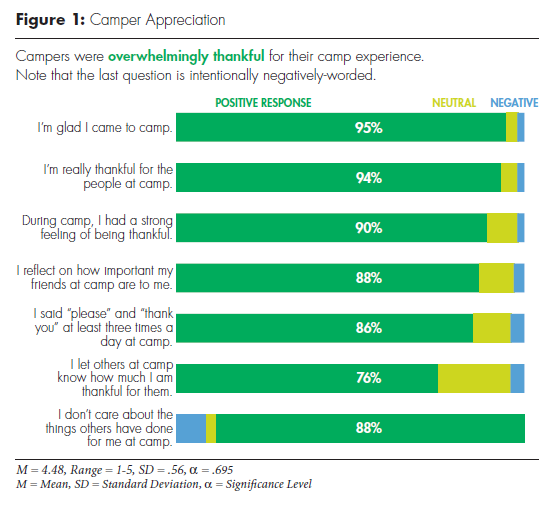
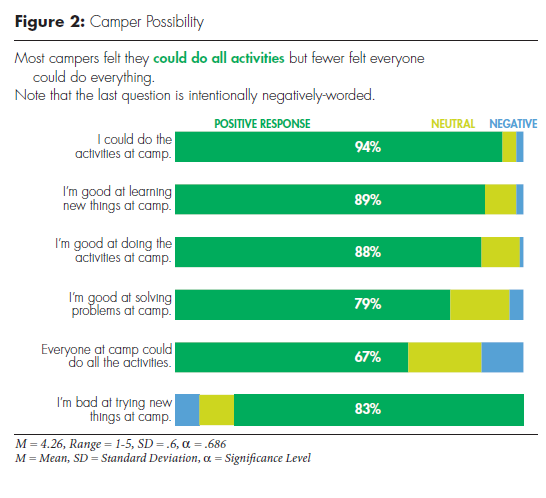
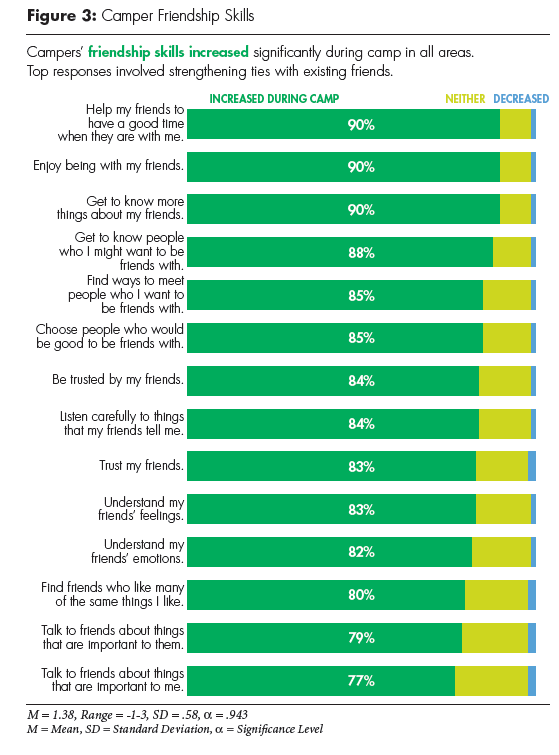
Two hundred and twenty parents/ caregivers completed online surveys after each session. Parents/caregivers answered one item each about their perceived changes in their children's appreciation and possibility, and completed the fouritem ACA parent-perception friendship skills scale (Figure 4; ACA Parent Perceptions Tool, 2014). Camper and parent/caregiver data on the three outcomes were analyzed using descriptive statistics. Relationships between camper and parent data were explored using t-tests.
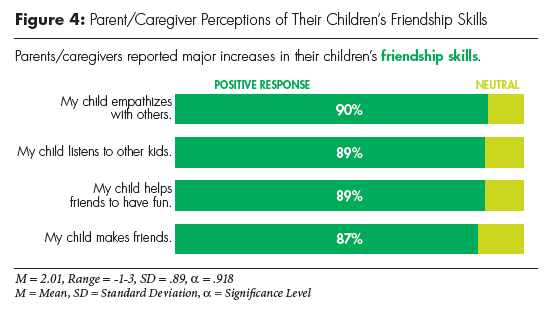
Results
Campers reported gains in all the outcomes measured: appreciation (M = 4.48, SD = .56, α = .695; Figure 1), possibility (M = 4.26, SD = .60, α = .686; Figure 2), and friendship skills (M = 1.38, SD = .58, α = .943; Figure 3). Regarding parent/ caregiver and camper perceptions of friendship skills, there was a notable difference between camper (M = 1.38) and parent/caregiver perceptions of friendship skills gained (M = 2.01, SD = .89, α = .918, Figure 4). This difference between means of .63, CI [.52, .75] was significant (t(627)=10.8, p < .001, Figure 5).
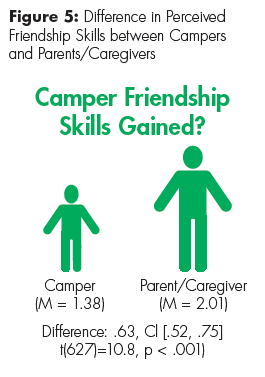
Discussion and Implications
Campers agreed that they experienced appreciation and possibility at camp. Campers also reported that their friendship skills increased. The finding that so many campers experienced such positive outcomes is important for youth with serious illnesses who typically struggle to develop social and personal outcomes because of their isolation and delays in development due to illness (Miauton et al., 2003; Woods, Mayes, Bartley, Fedele, & Ryan, 2013).
The findings from this study provide evidence of alignment between camp's values and camper outcomes. The finding that parents perceived their children gained more than the campers thought they did was interesting but not surprising. Initial psychometric testing of the parent perceptions tool (Sibthorp & Bennett, 2013) indicated low correlations between camper and parent reports, meaning what makes camp successful for campers is not always wellaligned with parents' ideas of success. Another possibility is that, in our study, the time between when campers completed their surveys (at the end of camp) and when parents/caregivers completed surveys a few days or weeks later might have magnified outcomes. A third possibility is that parents/caregivers had an inflated perception of the effect of camp on children because they wanted to believe their investment of time and effort in sending their children to camp was warranted.
As a retrospective post-test-only evaluation, this study cannot be generalized to all populations or settings, nor does the study make any assumptions about lasting change. The internally developed scales for appreciation and possibility could use further testing and refinement.
This evaluation contributes to the camp profession by developing and sharing tools to examine the outcomes of appreciation and possibility, expanding the use of the friendship skills scale to a medical specialty camp, and providing encouragement to collect data from multiple perspectives. Future considerations include measuring campers' changes in appreciation, possibility, and friendship skills from the additional perspective of adult counselors and relating these data to data from campers and parents/caregivers. As camp professionals continue to find ways to harness the power of camp, this study provides additional documentation of the impact of camp from the perspectives of campers and parents/caregivers while providing inspiration for intentional and meaningful programming.
References
American Camp Association. (2011). Youth outcomes battery. Martinsville, IN.
American Camp Association. (2014). Parent perceptions tool. Martinsville, IN.
Beckwitt, A.E. (2014). Childhood cancer camps: Their role in adults surviving childhood cancers lives. Journal of Pediatric Oncology Nursing, 31(1), 34-40.
Carlson, K.P., & Cook, M. (2007). Challenge by choice: Adventure-based counseling for seriously ill adolescents. Child and Adolescent Psychiatric Clinics of North America, 16, 909-919.
Faith, M.A., Reed, G., Heppner, C.E., Hamill, L.C., Tarkenton, T.R., & Donewar, C.W. (2015). Bullying in medically fragile youth: A review of risks, protective factors, and recommendations for medical providers. Journal of Developmental and Behavioral Pediatrics, 36(4), 285-301.
Gillard, A. (2014, July/August). Fun, safety, camaraderie, and outdoor adventure at the Hero's Journey program. Camping Magazine.
Gillard, A., Witt, P.A., & Watts, C.E. (2011). Outcomes and processes at a camp for youth with HIV/AIDS. Qualitative Health Research, 21(11), 1508-1526.
Goodwin, D.L., & Staples, K. (2005). The meaning of summer camp experiences to youths with disabilities. Adapted Physical Activity Quarterly, 22(2), 160-178.
Lerner, R.M., & Castellino, D.R. (2002). Contemporary developmental theory and adolescence: Developmental systems and applied developmental science. Journal of Adolescent Health, 31, 122-135.
Miauton, L., Narring, F., & Michaud, P.A. (2003). Chronic illness, life style, and emotional health in adolescence: Results of a cross-sectional survey on the health of 15-20-year-olds in switzerland. European Journal of Pediatrics, 162(10), 682-689.
Moola, F.J., Faulkner, G.E.J., White, L., & Kirsh, J.A. (2014). The psychological and social impact of camp for children with chronic illnesses: A systematic review update. Child: Care, Health and Development, 40(5), 615-631.
Sibthorp, J. & Bennett, T. (2013). Youth outcomes battery staff and parent perceptions versions: Report to the American Camp Association and the ACA Not-for-Profit Council. University of Utah, Salt Lake City, UT.
Stam, H., Hartman, E.E., Deurloo, J.A., Groothoff, J., & Grootenhuis, M.A. (2006). Young adult patients with a history of pediatric disease: Impact on course of life and transition into adulthood. Journal of Adolescent Health, 39, 4-13.
Taylor, R.M., Gibson, F., & Franck, L.S. (2008). The experience of living with a chronic illness during adolescence: A critical review of the literature. Journal of Clinical Nursing, 17(23), 3083-3091.
Woods, K., Mayes, S., Bartley, E., Fedele, D., & Ryan, J. (2013). An evaluation of psychosocial outcomes for children and adolescents attending a summer camp for youth with chronic illness. Children's Health Care, 42(1), 85-98.
Ann Gillard, PhD, is the director of research and evaluation at the Hole in the Wall Gang Camp. She can be reached at Ann.Gillard@ holeinthewallgang.org.
Mark F. Roark, PhD, is a consultant in youth outcomes and focused on quality outcomes for this study.

